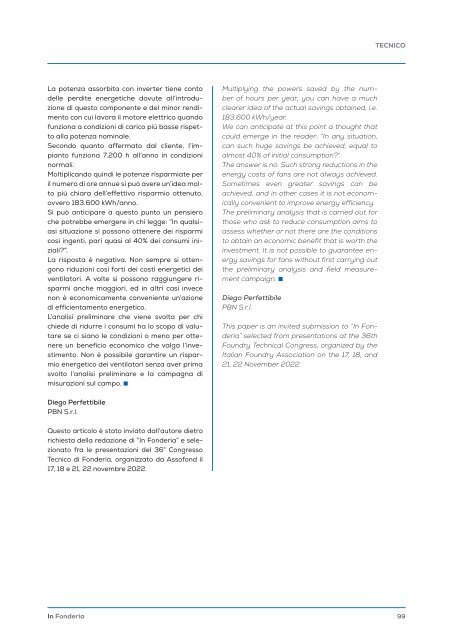In Fonderia 3 2023
Terzo numero del 2023 di In Fonderia
Terzo numero del 2023 di In Fonderia
Create successful ePaper yourself
Turn your PDF publications into a flip-book with our unique Google optimized e-Paper software.
TECNICO<br />
La potenza assorbita con inverter tiene conto<br />
delle perdite energetiche dovute all’introduzione<br />
di questo componente e del minor rendimento<br />
con cui lavora il motore elettrico quando<br />
funziona a condizioni di carico più basse rispetto<br />
alla potenza nominale.<br />
Secondo quanto affermato dal cliente, l’impianto<br />
funziona 7.200 h all’anno in condizioni<br />
normali.<br />
Moltiplicando quindi le potenze risparmiate per<br />
il numero di ore annue si può avere un’idea molto<br />
più chiara dell’effettivo risparmio ottenuto,<br />
ovvero 183.600 kWh/anno.<br />
Si può anticipare a questo punto un pensiero<br />
che potrebbe emergere in chi legge: “<strong>In</strong> qualsiasi<br />
situazione si possono ottenere dei risparmi<br />
così ingenti, pari quasi al 40% dei consumi iniziali?”.<br />
La risposta è negativa. Non sempre si ottengono<br />
riduzioni così forti dei costi energetici dei<br />
ventilatori. A volte si possono raggiungere risparmi<br />
anche maggiori, ed in altri casi invece<br />
non è economicamente conveniente un’azione<br />
di efficientamento energetico.<br />
L’analisi preliminare che viene svolta per chi<br />
chiede di ridurre i consumi ha lo scopo di valutare<br />
se ci siano le condizioni o meno per ottenere<br />
un beneficio economico che valga l’investimento.<br />
Non è possibile garantire un risparmio<br />
energetico dei ventilatori senza aver prima<br />
svolto l’analisi preliminare e la campagna di<br />
misurazioni sul campo. <br />
Multiplying the powers saved by the number<br />
of hours per year, you can have a much<br />
clearer idea of the actual savings obtained, i.e.<br />
183,600 kWh/year.<br />
We can anticipate at this point a thought that<br />
could emerge in the reader: “<strong>In</strong> any situation,<br />
can such huge savings be achieved, equal to<br />
almost 40% of initial consumption?”.<br />
The answer is no. Such strong reductions in the<br />
energy costs of fans are not always achieved.<br />
Sometimes even greater savings can be<br />
achieved, and in other cases it is not economically<br />
convenient to improve energy efficiency.<br />
The preliminary analysis that is carried out for<br />
those who ask to reduce consumption aims to<br />
assess whether or not there are the conditions<br />
to obtain an economic benefit that is worth the<br />
investment. It is not possible to guarantee energy<br />
savings for fans without first carrying out<br />
the preliminary analysis and field measurement<br />
campaign. <br />
Diego Perfettibile<br />
PBN S.r.l.<br />
This paper is an invited submission to “<strong>In</strong> <strong>Fonderia</strong>”<br />
selected from presentations at the 36th<br />
Foundry Technical Congress, organized by the<br />
Italian Foundry Association on the 17, 18, and<br />
21, 22 November 2022.<br />
Diego Perfettibile<br />
PBN S.r.l.<br />
Questo articolo è stato inviato dall’autore dietro<br />
richiesta della redazione di “<strong>In</strong> <strong>Fonderia</strong>” e selezionato<br />
fra le presentazioni del 36° Congresso<br />
Tecnico di <strong>Fonderia</strong>, organizzato da Assofond il<br />
17, 18 e 21, 22 novembre 2022.<br />
<strong>In</strong> <strong>Fonderia</strong><br />
99














